Deconstructivism

해체주의는 1980년대에 등장한 포스트모던 건축의 한 운동이다. 이는 일반적으로 명백한 조화, 연속성 또는 대칭의 부재로 특징지어지며, 건설된 건물이 파편화된 인상을 준다. 해체주의라는 명칭은 구성주의 그리고 프랑스 철학자 자크 데리다(1930~2004)에 의해 개발된 기호학적 분석의 한 형태인 “해체”의 포트만투(합성어; 원래 대형 여행 가방의 뜻. 여러 가지로 이뤄진, 혼성의 의미)다. 작업이 종종 해체주의적으로 묘사되는 건축가들(많은 경우 건축가들 자신은 그 라벨을 거부하지만)에는 자하 하디드(1950~2016), 피터 아이젠만(1932~), 프랭크 게리(1929~), 렘 콜하스(1944~), 다니엘 리베스킨트(1946~), 베르나르 추미(1944~) 및 쿱 힘멜블라우(1968 개소; 멤버 3인 중 볼프 D. 프릭스가 1942~) 등이 있다.
Deconstructivism is a movement of postmodern architecture which appeared in the 1980s. It gives the impression of the fragmentation of the constructed building, commonly characterised by an absence of obvious harmony, continuity, or symmetry. Its name is a portmanteau of Constructivism and “Deconstruction”, a form of semiotic analysis developed by the French philosopher Jacques Derrida. Architects whose work is often described as deconstructivist (though in many cases the architects themselves reject the label) include Zaha Hadid, Peter Eisenman, Frank Gehry, Rem Koolhaas, Daniel Libeskind, Bernard Tschumi, and Coop Himmelb(l)au.[
이 용어는 본래 영어 형용사가 암시하는 것처럼 스타일의 해체된 시각화를 의미하는 것이 아니라, (프랑스어를 통해) 고전 건축의 “규칙을 깨뜨린” 1차 세계대전 중 러시아 구성주의 운동에 대한 이 운동의 기초에서 유래했다.
The term does not inherently refer to the style’s deconstructed visuals as the English adjective suggests, but instead derives from the movement’s foundations in contrast to the Russian Constructivist movement during the First World War that “broke the rules” of classical architecture through the French language.
해체주의는 분열(파쇄) 외에도 종종 구조물의 표피를 조작하고 비-직선형 모양을 배치하여 건축의 확립된 (기존) 요소를 왜곡하고 탈구시키는 것처럼 보이게 하는 경우가 많다. 완성된 시각적 외관은 예측불가능하고 통제된 혼돈이 특징이다.
Besides fragmentation, deconstructivism often manipulates the structure’s surface skin and deploys non-rectilinear shapes which appear to distort and dislocate established elements of architecture. The finished visual appearance is characterized by unpredictability and controlled chaos.
역사, 맥락 및 영향
History, context and influences
해체주의는 1982년 라 빌레트 공원 건축 디자인 설계경기 – 특히 자크 데리다와 피터 아이젠만의 참가작과 베르나르 추미의 우승작 – 뿐만 아니라 1988년 모마(MoMA; 뉴욕현대미술관)에서 필립 존슨(1906~2005)과 마크 위글리(1956~)가 주최한 〈해체주의 건축〉 전시를 통해 대중에게 알려졌다. 추미는 이 건축가들의 작업을 “운동” 또는 새로운 “스타일”이라고 부르는 것은 맥락에 맞지 않고 그들의 사상에 대한 이해가 부족하다고 말하며, 해체주의는 단순히 그가 “합판으로 도리스 양식 신전 형태를 만드는 것”과 관련 있다고 말했던 포스트모더니즘의 실천에 반대하는 움직임이라고 믿었다.
Deconstructivism came to public notice with the 1982 Parc de la Villette architectural design competition, in particular the entry from Jacques Derrida and Peter Eisenman and the winning entry by Bernard Tschumi, as well as the Museum of Modern Art’s 1988 exhibition in New York, organized by Philip Johnson and Mark Wigley. Tschumi stated that calling the work of these architects a “movement” or a new “style” was out of context and showed a lack of understanding of their ideas, and believed that Deconstructivism was simply a move against the practice of Postmodernism, which he said involved “making Doric temple forms out of plywood”.
다른 영향력 있는 전시로는 피터 아이젠만에 의해 디자인된 (미국 오하이오주) 콜럼버스 웩스너 시각예술센터의 개관(전)이 있다. 이 뉴욕 전시회에는 프랭크 게리, 다니엘 리베스킨트, 렘 콜하스, 피터 아이젠만, 자하 하디드, 쿱 힘멜블라우, 그리고 베르나르 추미의 작업이 선보여졌다. 이 전시 이후, 해체주의와 관련된 일부 건축가들은 해체주의로부터 거리를 두었다; 그럼에도 불구하고, 이 용어는 동시대 (현대) 건축의 일반적인 트렌드로 자리 잡았다.
Other influential exhibitions include the 1989 opening of the Wexner Center for the Arts in Columbus, designed by Peter Eisenman. The New York exhibition has featured works by Frank Gehry, Daniel Libeskind, Rem Koolhaas, Peter Eisenman, Zaha Hadid, Coop Himmelb(l)au, and Bernard Tschumi. Since their exhibitions, some architects associated with Deconstructivism have distanced themselves from it; nonetheless, the term has stuck and has come to embrace a general trend within Contemporary architecture.
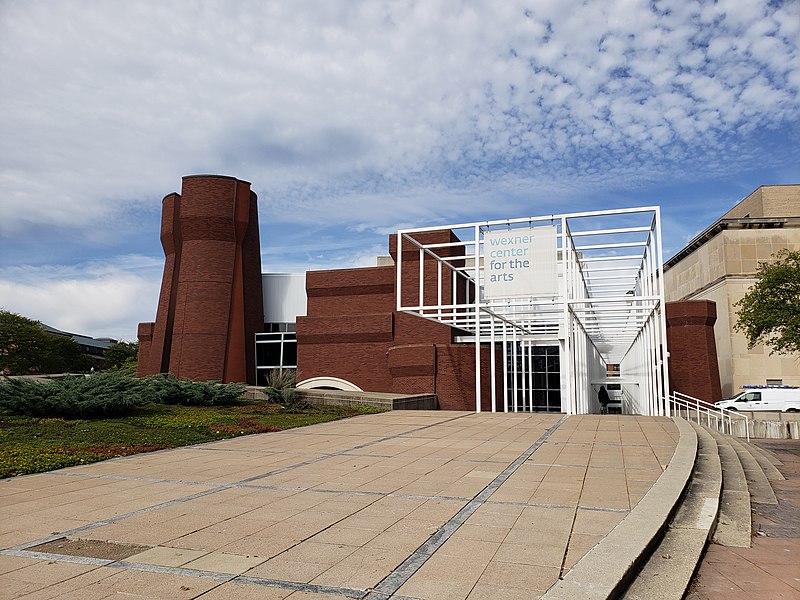

모더니즘과 포스트모더니즘
Modernism and postmodernism
현대 건축에서 ‘해체주의’라는 용어는 모더니즘과 포스트모더니즘의 질서정연한 합리성에 반대되는 개념이다. 포스트모더니스즘과 발생기의 해체주의 건축가들 모두 《오퍼지션》(1973~1984 발간) 저널에 게재되었지만, 그 저널의 내용은 두 운동 사이에 결정적인 단절을 가져왔다. 해체주의는 건축을 “분해”하기를 원하면서, 건축사에 대립적인 입장을 취했다. 포스트모더니즘은 모더니즘이 기피했던 역사적 참조를 수용하기 위해 돌아왔지만, 아마도 아이러니하게도, 해체주의는 포스트모더니즘이 그러한 참조를 수용하는 것뿐만 아니라 장식을 나중에 덧붙인 사후적인 생각이나 장식으로 여기는 관념을 거부했다.
The term ‘Deconstructivism’ in contemporary architecture is opposed to the ordered rationality of Modernism and Postmodernism. Though postmodernist and nascent deconstructivist architects both published in the journal Oppositions (published between 1973 and 1984), that journal’s contents mark a decisive break between the two movements. Deconstructivism took a confrontational stance to architectural history, wanting to “disassemble” architecture. While postmodernism returned to embrace the historical references that modernism had shunned, possibly ironically, deconstructivism rejected the postmodern acceptance of such references, as well as the idea of ornament as an after-thought or decoration.
《오퍼지션》 외에도, 해체주의와 포스트모더니즘을 정의하는 텍스트는 로버트 벤투리의 『건축의 복합성과 대립성』(1966)이었다. 그것은 모더니즘의 순수성, 명확성, 단순성에 반대한다고 주장한다. 이 책이 출판되면서, 모더니즘의 두 가지 주요 분야인 기능주의와 합리주의가 패러다임으로 전복되었다. 포스트모더니스트 벤투리의 해석은 장식과 역사적 암시가 모더니즘이 잊은 건축의 풍요로움을 더한다고 주장했다. 일부 포스트모던 건축가들은 벤투리가 “데커레이티드 셰드(장식된 헛간; 전체적으로 실용성을 추구하되 정면은 위엄 있는 디자인)”라고 묘사한 경제적이고 미니멀한 건물에도 장식(오너먼트)을 다시 적용하려고 노력했다. 디자인의 합리주의는 무시됐지만 건물의 기능주의는 여전히 어느 정도 그대로 유지되었다. 이것은 벤투리의 다음 주요 작업인, 간판과 장식을 실용적인 건축에 적용하고 기호학의 철학적 복잡성을 주입할 수 있다는 논문에 가깝다.
In addition to Oppositions, a defining text for both deconstructivism and postmodernism was Robert Venturi’s Complexity and Contradiction in Architecture (1966). It argues against the purity, clarity and simplicity of modernism. With its publication, functionalism and rationalism, the two main branches of modernism, were overturned as paradigms. The reading of the postmodernist Venturi was that ornament and historical allusion added a richness to architecture that modernism had foregone. Some Postmodern architects endeavored to reapply ornament even to economical and minimal buildings, described by Venturi as “the decorated shed.” Rationalism of design was dismissed but the functionalism of the building was still somewhat intact. This is close to the thesis of Venturi’s next major work, that signs and ornament can be applied to a pragmatic architecture, and instill the philosophic complexities of semiology.
『건축의 복합성과 대립성』에 대한 해체주의적 독해는 상당히 다르다. 기본 토대(basic building block)는 해체주의에서의 복잡한 여러 문제들과 내용의 주제였으며, 장식을 위한 분리는 없었다. 벤투리와 같은 포스트모더니스트처럼 장식과 기능을 분리하는 대신, 건물의 기능적 측면에 의문을 제기했다. 문제의 대상, 장식이 포스트모더니스트에게 그렇듯 기하학은 해체주의자들을 위한 것이었고, 기하학의 이 복잡성은 차례로 해체주의 건물의 기능, 구조, 공간적 측면에 적용됐다. 해체주의적 복합성의 한 가지 예는 바일-암-라인에 있는 프랭크 게리의 비트라 디자인 뮤지엄인데, 이는 모더니스트 아트 갤러리의 전형적인 장식되지 않은 화이트 큐브를 가져다가 입체파와 추상표현주의를 연상시키는 기하학을 사용하여 해체한다. 이것은 모더니스트적 단순함의 기능적 측면을 전복하는 동시에 모더니즘, 특히 화이트 스터코 스킨이 연상되는, 국제양식 스타일을 출발점으로 삼는다. 『건축의 복합성과 대립성』에 대한 해체주의자적 독해의 또 다른 예는 피터 아이젠만의 웩스너 시각예술센터다. 웩스너 센터는 성으로부터 원형을 취한 다음, 일련의 절개 및 파편화에 복합(잡)성을 가득 채운다. 3차원 그리드(격자)는, 건물을 다소 임의로 통과한다. 모더니즘에 대한 레퍼런스로서의 그리드는, 그것은 장신구로서, 중세 성의 유물과 충돌한다. 일부 그리드의 기둥은 의도적으로 지면에 닿지 않고, 계단 위로 맴돌면서 신경증적인 불안을 유발하고 기둥의 구조적 목적에 모순된다. 웩스너 센터는 성의 원형을 해체하고 그 공간과 구조를 갈등과 차이로 표현한다.
The deconstructivist reading of Complexity and Contradiction is quite different. The basic building was the subject of problematics and intricacies in deconstructivism, with no detachment for ornament. Rather than separating ornament and function, like postmodernists such as Venturi, the functional aspects of buildings were called into question. Geometry was to deconstructivists what ornament was to postmodernists, the subject of complication, and this complication of geometry was in turn, applied to the functional, structural, and spatial aspects of deconstructivist buildings. One example of deconstructivist complexity is Frank Gehry’s Vitra Design Museum in Weil-am-Rhein, which takes the typical unadorned white cube of modernist art galleries and deconstructs it, using geometries reminiscent of cubism and abstract expressionism. This subverts the functional aspects of modernist simplicity while taking modernism, particularly the international style, of which its white stucco skin is reminiscent, as a starting point. Another example of the deconstructivist reading of Complexity and Contradiction is Peter Eisenman’s Wexner Center for the Arts. The Wexner Center takes the archetypal form of the castle, which it then imbues with complexity in a series of cuts and fragmentations. A three-dimensional grid, runs somewhat arbitrarily through the building. The grid, as a reference to modernism, of which it is an accoutrement, collides with the medieval antiquity of a castle. Some of the grid’s columns intentionally don’t reach the ground, hovering over stairways creating a sense of neurotic unease and contradicting the structural purpose of the column. The Wexner Center deconstructs the archetype of the castle and renders its spaces and structure with conflict and difference.
해체주의 철학
Deconstructivist philosophy
일부 해체주의 건축가는 프랑스 철학자 자크 데리다의 영향을 받았다. 아이젠만은 데리다의 친구였지만, 건축 디자인에 대한 그의 접근 방식은 그가 해체주의자가 되기 훨씬 전에 개발되었다. 그에게 해체주의는 급진적 형식주의에 대한 관심의 연장으로 간주되어야 한다. 해체주의의 일부 실무자들은 러시아 구성주의의 형식적 실험과 기하학적 불균형의 영향을 받았다. 해체주의에는 20세기 운동(모더니즘/포스트모더니즘 상호작용, 표현주의, 입체파, 미니멀리즘 및 컨템퍼러리 아트)에 대한 추가적인 참조가 있다. 해체주의는 “형태는 기능을 따른다”, “형태의 순수성”, 그리고 “재료에 대한 진실” 같은 모더니즘의 제한적 ‘규칙’에서 벗어나려고 시도한다.
Some Deconstructivist architects were influenced by the French philosopher Jacques Derrida. Eisenman was a friend of Derrida, but even so his approach to architectural design was developed long before he became a Deconstructivist. For him Deconstructivism should be considered an extension of his interest in radical formalism. Some practitioners of deconstructivism were also influenced by the formal experimentation and geometric imbalances of Russian constructivism. There are additional references in deconstructivism to 20th-century movements: the modernism/postmodernism interplay, expressionism, cubism, minimalism and contemporary art. Deconstructivism attempts to move away from the supposedly constricting ‘rules’ of modernism such as “form follows function,” “purity of form,” and “truth to materials.”
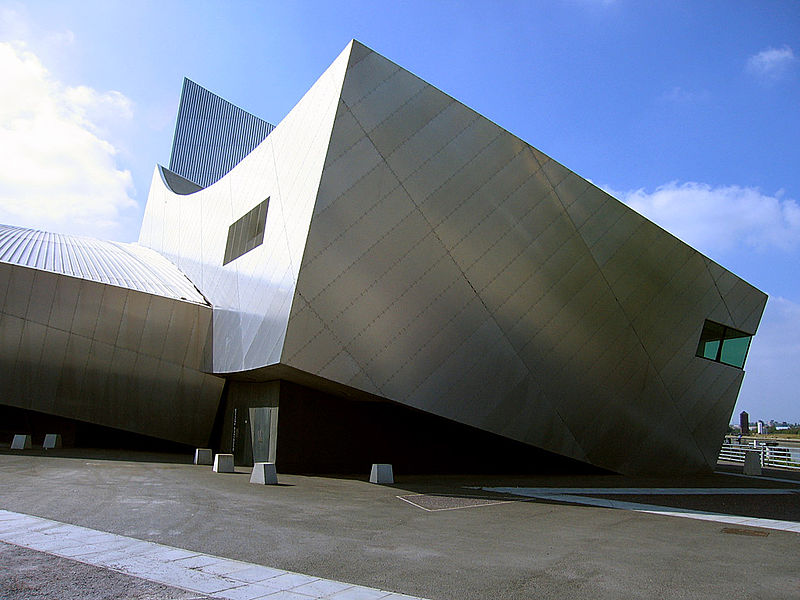
해체주의 철학에서 건축 이론에 이르는 주요 통로는 철학자 자크 데리다가 피터 아이젠만에 미치는 영향을 통해 이루어졌다. 아이젠만은 문학 운동인 해체론으로부터 일부 철학적 기반을 도출하고, 『코라 L 웍스』(1997)에 기록된 라 빌레트 공원 설계경기 참가작을 포함한 여러 프로젝트에서 데리다와 직접 협력했다. 데리다와 아이젠만뿐만 아니라 다니엘 리베스킨트는 모두 “현전의 형이상학”에 관심을 가졌고, 이것이 건축 이론에서 해체주의 철학의 주요 주제다. 건축은 의미를 전달하고, 언어 철학의 방법에 의해 치료 받을 수 있는 언어라는 것이 전제다. 존재와 부재, 또는 솔리드와 보이드의 변증법은 지어진 것이든 지어지지 않은 것이든 간에, 아이젠만의 많은 프로젝트에서 발견된다. 데리다와 아이젠만은 모두 그 장소(로커스), 또는 현전의 장소가 건축이며, 존재와 부재의 동일한 변증법이 건축물과 해체주의에서 발견된다고 믿는다.
The main channel from deconstructivist philosophy to architectural theory was through the philosopher Jacques Derrida’s influence with Peter Eisenman. Eisenman drew some philosophical bases from the literary movement Deconstruction, and collaborated directly with Derrida on projects including an entry for the Parc de la Villette competition, documented in Chora l Works. Both Derrida and Eisenman, as well as Daniel Libeskind were concerned with the “metaphysics of presence,” and this is the main subject of deconstructivist philosophy in architecture theory. The presupposition is that architecture is a language capable of communicating meaning and of receiving treatments by methods of linguistic philosophy. The dialectic of presence and absence, or solid and void occurs in much of Eisenman’s projects, both built and unbuilt. Both Derrida and Eisenman believe that the locus, or place of presence, is architecture, and the same dialectic of presence and absence is found in construction and deconstructivism.
데리다에 따르면, 텍스트 읽기는 고전적 내러티브 구조를 다룰 때 가장 잘 수행된다. 모든 건축적 해체주의는 특정한 전형적 구축의 존재를 필요로 하는데, 이는 유연하게 대항할 수 있는 강하게 확립된 전통적 기대다. 프랭크 게리가 소유한 산타 모니카 저택(1978)의 디자인은 해체주의 건축의 원형으로 꼽힌다. 그의 출발점은 의도된 사회적 의미의 전형적인 집합으로 구현된 원형적인 교외 주택이었다. 게리는 “해체”의 행위인, 유희적 전복으로 매스, 공간의 외피, 수평면 및 기타 기대치를 변경했다.
According to Derrida, readings of texts are best carried out when working with classical narrative structures. Any architectural deconstructivism requires the existence of a particular archetypal construction, a strongly-established conventional expectation to play flexibly against. The design of Frank Gehry’s own Santa Monica residence, (from 1978), has been cited as a prototypical deconstructivist building. His starting point was a prototypical suburban house embodied with a typical set of intended social meanings. Gehry altered its massing, spatial envelopes, planes and other expectations in a playful subversion, an act of “deconstruction”.
현전의 형이상학과 해체주의에 대한 데리다의 개념에 더하여, 그의 에크리튀르(écriture; 문자, 쓰기)와 원-에크리튀르(원-문자, 원-쓰기) 철학에서 구체화된 추적과 소거에 대한 관념은, 해체주의 기념비에도 적용되었다. 다니엘 리베스킨트는 그의 초기 프로젝트를 글쓰기 또는 글쓰기에 대한 담론의 형태로 구상했으며 종종 구체적인 시(詩)의 형태로 작업했다. 그는 책으로 건축적 조형물을 만들었고, 종종 텍스트로 모델을 코팅하여, 드러내 놓고 그의 건축물이 글쓰기를 참조하도록 했다. 추적과 소거에 대한 관념은 리베스킨트가 에세이와 베를린 유대인 박물관 프로젝트에서 채택했다. 이 박물관은 홀로코스트의 소거된 흔적으로 상상되는데, 그 주제를 읽기 쉽고 가슴 아프게 만들기 위해 의도됐다. 마야 린(1959~)의 베트남 참전용사 기념비 및 피터 아이젠만의 유대인 학살 추모 공원과 같은 기념관 또한 추적과 소거의 주제를 반영하고 있다고 한다.
In addition to Derrida’s concepts of the metaphysics of presence and deconstructivism, his notions of trace and erasure, embodied in his philosophy of writing and arche-writing found their way into deconstructivist memorials. Daniel Libeskind envisioned many of his early projects as a form of writing or discourse on writing and often works with a form of concrete poetry. He made architectural sculptures out of books and often coated the models in texts, openly making his architecture refer to writing. The notions of trace and erasure were taken up by Libeskind in essays and in his project for the Jewish Museum Berlin. The museum is conceived as a trace of the erasure of the Holocaust, intended to make its subject legible and poignant. Memorials such as Maya Lin’s Vietnam Veterans Memorial and Peter Eisenman’s Memorial to the Murdered Jews of Europe are also said to reflect themes of trace and erasure.
구성주의 및 러시아 미래주의
Constructivism and Russian Futurism
해체주의 건축에서 또 다른 주요 흐름은 20세기 초의 구성주의 및 러시아 미래주의 운동으로부터 영감을 얻었는데, 그들의 그래픽과 그들의 비저너리 아키텍처 모두에서, 실제로 건설된 것은 거의 없다.
Another major current in deconstructivist architecture takes inspiration from the Constructivist and Russian Futurist movements of the early twentieth century, both in their graphics and in their visionary architecture, little of which was actually constructed.
예술가 나움 가보(1890~1977), 엘 리시츠키(1890~1941), 카지미르 말레비치(1879~1935), 알렉산더 로드첸코(1891~1956)는 자하 하디드 및 쿱 힘멜블라우 같은 해체주의 건축가들의 기하학적 형태의 그래픽 감각에 영향을 미쳤다. 해체주의와 구성주의는 모두 추상적인 아상블라주를 만드는 텍토닉(건축의 구축성)에 관심을 가졌다. 둘 다 그래픽, 조각, 건축으로 표현되는 주요 예술 콘텐츠로서, 기하학적 형태의 근본적인 단순성에 관심을 기울였다. 그렇지만, 순수주의에 대한 구성주의적 경향은 해체주의에는 존재하지 않는다: 형태는 종종 구조가 해체될 때 변형된다. 또한 사회주의 및 집산주의의 대의명분을 옹호하는 행위가 감소하거나 부재한다.
Artists Naum Gabo, El Lissitzky, Kazimir Malevich, and Alexander Rodchenko, have influenced the graphic sense of geometric forms of deconstructivist architects such as Zaha Hadid and Coop Himmelb(l)au. Both Deconstructivism and Constructivism have been concerned with the tectonics of making an abstract assemblage. Both were concerned with the radical simplicity of geometric forms as the primary artistic content, expressed in graphics, sculpture and architecture. The Constructivist tendency toward purism, though, is absent in Deconstructivism: form is often deformed when construction is deconstructed. Also lessened or absent is the advocacy of socialist and collectivist causes.
구성주의의 주요 그래픽 모티프는 직사각형 막대와 삼각형 쐐기였으며, 그 외에는 정사각형 및 원이라는 보다 기본적인 기하학이 있었다. 엘 리시츠키는 〈프라운〉 시리즈에서 공간에 자유롭게 떠다니는 다양한 각도의 기하학 컬렉션을 아상블라주 했다. 그것들은 느슨하게 부착되거나, 쌓이거나, 흩어져 있는 철재 막대 또는 톱질한 목재 같은 기본적인 구조 단위를 연상시킨다. 또한 종종 초안으로 작성되어 기술 도면과 엔지니어링 도면 같은 측면을 공유한다. 다니엘 리베스킨트의 해체주의적 시리즈 〈마이크로메가〉도 비슷한 구성이다.
The primary graphic motifs of constructivism were the rectangular bar and the triangular wedge, others were the more basic geometries of the square and the circle. In his series Prouns, El Lizzitzky assembled collections of geometries at various angles floating free in space. They evoke basic structural units such as bars of steel or sawn lumber loosely attached, piled, or scattered. They were also often drafted and share aspects with technical drawing and engineering drawing. Similar in composition is the deconstructivist series Micromegas by Daniel Libeskind.
기울어지고 교차된 막대의 구성주의적 모티브를 도입하여 영향을 받는 벽을 상징적으로 해체함으로써 막대 자체를 정의하는 벽을 전복한다. … 이 겉으로 보이는 혼돈이 실제로 막대를 정의하는 벽을 구축한다; 그것은 구조다. 내부의 무질서는 막대의 길이를 따라 틈이 벌어지면서도 막대를 쪼개면서 막대를 생성한다.
ㅡ 필립 존슨 및 마크 위글리, 『해체주의 건축』, p.34
The symbolic breakdown of the wall effected by introducing the Constructivist motifs of tilted and crossed bars sets up a subversion of the walls that define the bar itself. … This apparent chaos actually constructs the walls that define the bar; it is the structure. The internal disorder produces the bar while splitting it even as gashes open up along its length.
ㅡ Phillip Johnson and Mark Wigley, Deconstructive Architecture, p. 34
현대 미술
Contemporary art
모던 아트의 두 계통인 미니멀리즘과 큐비즘은 해체주의에 영향을 미쳤다. 분석적 큐비즘은 형태와 내용을 동시에 다른 관점에서 해부하고 바라보기 때문에, 해체주의에 확실한 영향을 미쳤다. 분리(이탈)된 공간의 동시성은 프랭크 게리와 베르나르 추미의 많은 작업에서 분명하게 드러난다. 발견된 오브제 아트를 적용한 합성적 큐비즘은 분석적 큐비즘만큼 해체주의에 큰 영향을 미치지는 않지만, 프랭크 게리의 초기 및 더욱 버내큘러한 작업에서 여전히 발견된다. 해체주의는 또한 미니멀리즘과 문화적 참조로부터의 단절을 공유한다.
Two strains of modern art, minimalism and cubism, have had an influence on deconstructivism. Analytical cubism had a sure effect on deconstructivism, as forms and content are dissected and viewed from different perspectives simultaneously. A synchronicity of disjoined space is evident in many of the works of Frank Gehry and Bernard Tschumi. Synthetic cubism, with its application of found object art, is not as great an influence on deconstructivism as Analytical cubism, but is still found in the earlier and more vernacular works of Frank Gehry. Deconstructivism also shares with minimalism a disconnection from cultural references.
변형 및 전위를 지향하는 경향으로 인해, 해체주의와 관련된 표현파 및 표현주의 건축의 측면도 있다. 가끔은 해체주의가 표현주의, 신표현주의, 추상표현주의의 다양한 측면을 반영하기도 한다. 쿱 힘멜블라우가 디자인한 UFA 시네마 센터의 각진 형태는 장식되지 않은 매스에서 프란츠 클라인(미국 추상표현주의 화가, 1910~1962)의 번호가 매겨진 그림들의 추상적인 기하학을 상기시킨다. UFA 시네마 센터는 또한 에른스트 루트비히 키르히너(1880~1936)가 독일 도시의 거리 풍경에 묘사된 각진 인물들의 배경이 될 가능성이 높다. 바실리 칸딘스키의 작업도 해체주의 건축과 유사하다. 구상 작업에서 벗어나 추상표현주의로 나아간 그의 움직임은, 기하학을 위한 장식의 해체주의적 거부와 같은 정신 안에 있다.
With its tendency toward deformation and dislocation, there is also an aspect of expressionism and expressionist architecture associated with deconstructivism. At times deconstructivism mirrors varieties of expressionism, neo-expressionism, and abstract expressionism as well. The angular forms of the Ufa Cinema Center by Coop Himmelb(l)au recall the abstract geometries of the numbered paintings of Franz Kline, in their unadorned masses. The UFA Cinema Center also would make a likely setting for the angular figures depicted in urban German street scenes by Ernst Ludwig Kirchner. The work of Wassily Kandinsky also bears similarities to deconstructivist architecture. His movement into abstract expressionism and away from figurative work, is in the same spirit as the deconstructivist rejection of ornament for geometries.
1980년대와 1990년대의 몇몇 예술가들은 해체주의에 영향을 주거나 참여한 작업을 발표했다. 마야 린과 레이첼 화이트리드(1963~)가 두 사례다. 린의 1982년 베트남 참전용사 기념비 프로젝트는 화강암 판이 지상면을 절단하는 프로젝트 중 하나다. 파편-같은 형태와 미니멀리즘적 텍스트로 내용을 환원시키는 이 작업은 파편화의 감각과 기념비 읽기를 강조하는 해체주의에 영향을 미쳤다. 린은 또한 아이젠만의 웩스너 센터 작업에 기여했다. 레이첼 화이트리드의 캐스트(주물; 주형; 거푸집) 건축 공간은 현대 미술이 건축과 융합된 또 다른 사례다. 〈고스트〉(1990)는 전체 생활 공간을 석고로 캐스팅하여 보이드 공간을 굳힌 작품으로, 데리다의 건축적 현전에 대한 관념을 암시한다. 고든 마타 클락(1943~78)의 〈빌딩 컷〉(건물 자르기)은 미술관에 전시된 건물의 단면을 해체한 작품이다.
Several artists in the 1980s and 1990s contributed work that influenced or took part in deconstructivism. Maya Lin and Rachel Whiteread are two examples. Lin’s 1982 project for the Vietnam Veterans Memorial, with its granite slabs severing the ground plane, is one. Its shard-like form and reduction of content to a minimalist text influenced deconstructivism, with its sense of fragmentation and emphasis on reading the monument. Lin also contributed work for Eisenman’s Wexner Center. Rachel Whiteread’s cast architectural spaces are another instance where contemporary art is confluent with architecture. Ghost(1990), an entire living space cast in plaster, solidifying the void, alludes to Derrida’s notion of architectural presence. Gordon Matta-Clark’s Building cuts were deconstructed sections of buildings exhibited in art galleries.
1988 모마 전시
1988 MoMA exhibition
마크 위글리와 필립 존슨은 1988년 모마(MoMA; 현대미술관)에서 열린 〈해체주의적 건축〉 전시를 큐레이팅하여 이 운동을 구체화했고, 주요 실무자들에게 명성과 악명을 안겨주었다. 이 전시회에 참여한 건축가들은 피터 아이젠만, 프랭크 게리, 자하 하디드, 쿱 힘멜블라우, 렘 콜하스, 다니엘 리베스킨트, 베르나르 추미였다. 마크 위글리는 함께 실린 에세이를 통해, 각기 다른 작업으로 더 주목 받는 다양한 건축가들 사이에서 공통점을 보여주려고 노력했다.
Mark Wigley and Philip Johnson curated the 1988 Museum of Modern Art exhibition Deconstructivist architecture, which crystallized the movement, and brought fame and notoriety to its key practitioners. The architects presented at the exhibition were Peter Eisenman, Frank Gehry, Zaha Hadid, Coop Himmelblau, Rem Koolhaas, Daniel Libeskind, and Bernard Tschumi. Mark Wigley wrote the accompanying essay and tried to show a common thread among the various architects whose work was usually more noted for their differences.
이번 전시의 프로젝트는 순수한 형태에 대한 꿈이 흐트러진, 다른 감성을 보여준다.
이러한 프로젝트들을 해체적으로 만드는 것은 형태에 대한 우리의 생각을 방해하는 능력이다.
이 전시에서는 모더니즘의 숨겨진 잠재력을 활용하여 불안정한 건물을 건설하는 여러 건축가들 사이의 교차점으로서의 에피소드를 조사한다.
ㅡ 모마 『해체주의 건축』 (전시) 카탈로그에서 발췌한 필립 존슨 및 마크 위글리(의 글)
The projects in this exhibition mark a different sensibility, one in which the dream of pure form has been disturbed.
It is the ability to disturb our thinking about form that makes these projects deconstructive.
The show examines an episode, a point of intersection between several architects where each constructs an unsettling building by exploiting the hidden potential of modernism.
— Phillip Johnson and Mark Wigley, excerpt from the MoMA catalog
컴퓨터-지원 설계(CAD)
Computer-aided design
컴퓨터 지원 설계(CAD)는 이제 현대 건축의 대부분의 측면에서 필수적인 도구이지만, 해체주의의 특별한 특성으로 인해 컴퓨터의 사용이 특히 적절하다. 3차원 모델링과 애니메이션(가상 및 실제)은 매우 복잡한 공간을 구상하는 데 도움이 되며, 컴퓨터 모델을 제조용 지그(절삭 공구를 정해진 위치로 유도하는 장치; CAM; 컴퓨터 이용 제작)와 연결(링크)하는 기능은 미묘하게 다른 모듈 요소를 저렴한 비용으로 대량 생산할 수 있게 해준다. 또한, 게리는 디자인 프로세스의 일부로 컴퓨터 모델뿐만 아니라 많은 실제 모델을 제작하는 것으로도 유명하다. 컴퓨터 덕분에 복잡한 모양의 디자인이 훨씬 쉬워졌지만, 이상하게 보이는 모든 것이 “해체주의적”인 것은 아니다.
Computer-aided design is now an essential tool in most aspects of contemporary architecture, but the particular nature of deconstructivism makes the use of computers especially pertinent. Three-dimensional modelling and animation (virtual and physical) assists in the conception of very complicated spaces, while the ability to link computer models to manufacturing jigs (CAM – Computer-aided manufacturing) allows the mass production of subtly different modular elements to be achieved at affordable costs. Also, Gehry is noted for producing many physical models as well as computer models as part of his design process. Though the computer has made the designing of complex shapes much easier, not everything that looks odd is “deconstructivist.”
갤러리
Gallery
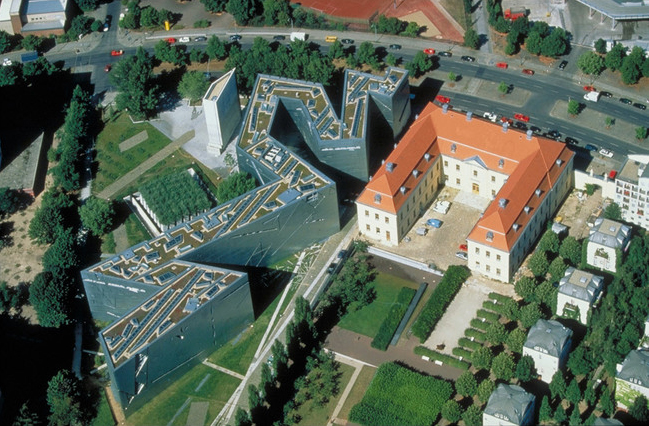




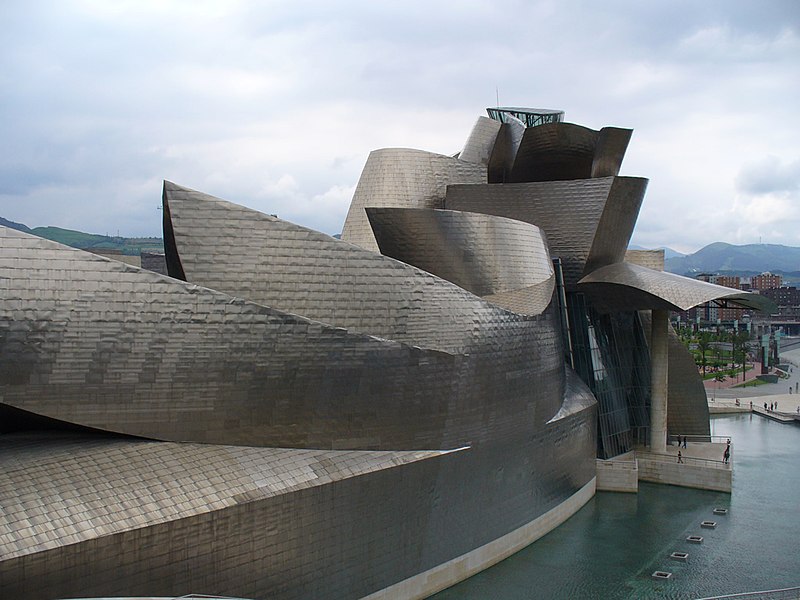

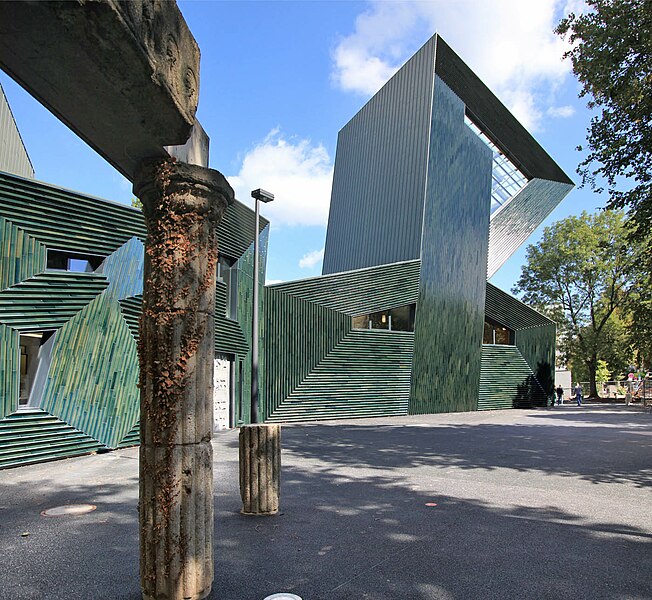
비판적 반응
Critical responses
케네스 프램튼의 『현대 건축 : 비판적 역사』(초판 1980)가 출간된 이후 건축 이론에서 비평의 역할에 대한 예리한 인식이 있어 왔다. 철학적 영향으로 데리다를 언급하는 동안, 해체주의는 포스트모더니즘의 다른 주요 파생물인 비판적 지역주의만큼이나 비판 이론에 기초를 두고 있다고 볼 수 있다. 비판 이론의 두 가지 측면인 긴급성과 분석은 해체주의에서 발견된다. 해체주의에서는 다른 작업 또는 선례를 재검토하고 비판하는 경향이 있으며, 또한 미학적 이슈를 전면에 두는 경향도 있다. 이에 대한 사례로 웩스너 센터를 들 수 있다. 그렇지만, 비판 이론의 핵심은 자본주의와 그 과잉에 대한 비판이었고, 그런 점에서 볼 때 해체주의자들의 작업 중 상당수는 – 디자인 관습에 대한 어떤 비판을 하더라도 – 엘리트를 위해 만들어지고 물건으로서 매우 비싸다면, 그 점에서 실패할 것이다.
Since the publication of Kenneth Frampton’s Modern Architecture: A Critical History(first edition 1980) there has been a keen consciousness of the role of criticism within architectural theory. Whilst referencing Derrida as a philosophical influence, deconstructivism can also be seen as having as much a basis in critical theory as the other major offshoot of postmodernism, critical regionalism. The two aspects of critical theory, urgency and analysis, are found in deconstructivism. There is a tendency to re-examine and critique other works or precedents in deconstructivism, and also a tendency to set aesthetic issues in the foreground. An example of this is the Wexner Center. Critical Theory, however, had at its core a critique of capitalism and its excess, and from that respect many of the works of the Deconstructivists would fail in that regard if only they are made for an elite and are, as objects, highly expensive, despite whatever critique they may claim to impart on the conventions of design.
해체주의의 비판성과 비판적 지역주의의 비판성의 차이점은, 비판적 지역주의는 관련된 전반적인 복잡성 수준을 줄이고 모더니즘적 건축을 지역적 차이와 조화시키려고 시도하면서 더 명확한 분석을 유지한다는 것이다. 사실상, 이것은 모더니즘적 “버내큘러”로 이어진다. 비판적 지역주의는 자기-비판의 결여와 장소에 대한 유토피아주의를 보여준다. 한편, 해체주의는, 외부 비판뿐만 아니라 자기-비판과 장소에 대한 디스토피아주의의 수준을 유지하고 복잡(합)성의 수준을 유지하는 경향이 있다. 이 운동으로 확인된, 특히 프랭크 게리를 비롯한 일부 건축가들은 해체주의자로 자신의 작업을 분류하는 것을 적극적으로 거부했다.
The difference between criticality in deconstructivism and criticality in critical regionalism, is that critical regionalism reduces the overall level of complexity involved and maintains a clearer analysis while attempting to reconcile modernist architecture with local differences. In effect, this leads to a modernist “vernacular.” Critical regionalism displays a lack of self-criticism and a utopianism of place. Deconstructivism, meanwhile, maintains a level of self-criticism and a dystopianism of place, as well as external criticism and tends towards maintaining a level of complexity. Some architects identified with the movement, notably Frank Gehry, have actively rejected the classification of their work as deconstructivist.
해체주의를 비판하는 사람들은 그것을 사회적 의미가 거의 없는 순전히 형식적인 활동(exercise)으로 본다. 케네스 프램튼은 그것을 “엘리티즘적이고 무심한(거리를 두는)” 것으로 여긴다. 니코스 A. 살린가로스는 해체주의를 파괴된 형태를 만들기 위해 디자인 사고를 침범하는 “바이러스적 표현”이라고 부른다; 이는 데리다와 필립 존슨의 설명과 기묘하게 유사한 반면, 전체 운동에 대한 가혹한 비난을 의미한다. 다른 비판은 해체주의 철학에 대한 비판과 유사한데, 해체주의는 경험적 과정이 아니기 때문에 건축가가 원하는 대로 결과가 나올 수 있으며, 따라서 일관성이 부족하다는 것이다. 오늘날에는 운동 초기의 철학적 토대가 사라졌다는 느낌이 있으며, 남은 것은 해체주의의 미학뿐이다. 다른 비판들은 건축이 언어학적 철학의 주제가 될 수 있는 언어라는 전제를 거부하거나, 또는, 과거에는 언어였다면 더 이상 그렇지 않다고 주장한다. 또 다른 사람들은 과거를 거부하면서 대체할 만한 명확한 가치를 제시하지 않으며 의도적으로 인간의 감각에 공격적인 전략을 추구하는 건축이 미래 세대에 미칠 지혜와 영향에 의문을 제기한다.
Critics of deconstructivism see it as a purely formal exercise with little social significance. Kenneth Frampton finds it “elitist and detached”. Nikos Salingaros calls deconstructivism a “viral expression” that invades design thinking in order to build destroyed forms; while curiously similar to both Derrida’s and Philip Johnson’s descriptions, this is meant as a harsh condemnation of the entire movement. Other criticisms are similar to those of deconstructivist philosophy—that since the act of deconstructivism is not an empirical process, it can result in whatever an architect wishes, and it thus suffers from a lack of consistency. Today there is a sense that the philosophical underpinnings of the beginning of the movement have been lost, and all that is left is the aesthetic of deconstructivism. Other criticisms reject the premise that architecture is a language capable of being the subject of linguistic philosophy, or, if it was a language in the past, critics claim it is no longer. Others question the wisdom and impact on future generations of an architecture that rejects the past and presents no clear values as replacements and which often pursues strategies that are intentionally aggressive to human senses.
- 출처 : 「Deconstructivism」, Wikipedia(en), 2021.1.6.
- 일본어 위키피디아는 ‘탈구축주의 건축(脱構築主義建築)’로 번역하고 있음.